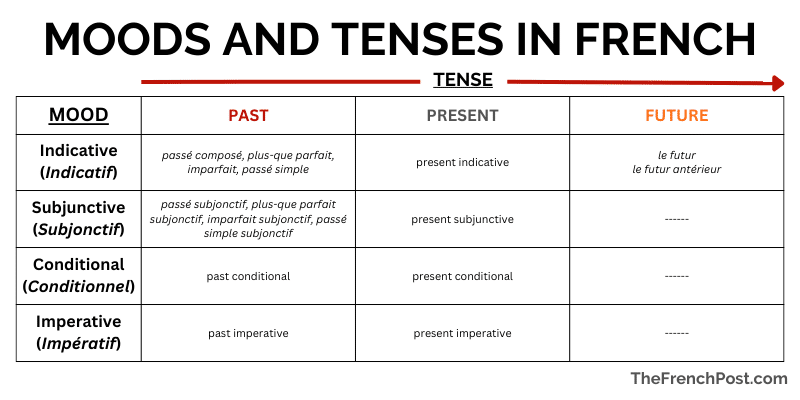
Talking about the past tense in French is a little more complicated than it is in English. To orient you to how the past works in French, consider this chart of moods versus tenses in French. The past is a tense, with different forms in different moods.
For this lesson we’re focusing on the “Past” column, where you’ll see a lot of options! Don’t get overwhelmed, though, because a few tenses are much more common than other forms.

The Four French verb moods
There are four “personal” moods in French. (The two “impersonal” moods, if you’re curious, are the infinitive and the participle forms of a verb, which are fixed words that do not get conjugated.)
1) The Indicative Mood
The indicative is the most common French verb mood and the one that all beginners learn first. Its past tenses describe events that have happened and implies a sense of certainty.
2) The Subjunctive Mood
Another verb mood is the “subjunctive“. Its past tenses describe events that might have occurred, could have occurred, etc., and imply a sense of uncertainty.
3) The Conditional Mood
The conditional mood is most often used in the present tense, but it also has a past tense form that we’ll discuss in this lesson. In the past tense, the conditional is used to describe events that depended on another situation in order to occur.
4) The Imperative Mood
Finally, the imperative mood describes commands and implies that something should be done. It’s almost always used in the present tense, but there is a past tense form of the imperative we’ll discuss briefly in this lesson.
Past Tense in French: The Indicative Mood
The most important past tenses to learn are the indicative past tenses. (Sidenote: if you ever want to check that you’re conjugating any verb correctly, into any mood and tense, I always use the conjugator here.)
The passé composé tense
The passé composé is the most basic past tense and the one that most beginners learn first. It is a two-part verb construction that uses a present tense auxiliary verb + a past participle. It describes specific things that happened in the past and are now over. For example:
Hier, j’ai vu un chien. (“Yesterday, I saw a dog.”)
In the passé composé, some verbs are conjugated with an être auxiliary verb, but most are conjugated with an avoir auxiliary verb.
Learn the passé composé tense with the “normal” avoir verbs →
Learn the passé composé tense with the “exception” être verbs →
The imparfait (imperfect) tense
This past tense is for actions that occurred over a period of time in the past. In the context of grammar, “perfect” means “finished”, so the imperfect tense is an “unfinished” tense; there is no definite start and end point to the action. For example:
Il pleuvait quand ils nous ont trouvés. (“It was raining when they found us.”)
The plus-que parfait tense
Plus-que parfait is used when you are already talking about the past, and you need to reference another action that occurred even before that past action. It’s a kind of “past past tense”.
A l’époque, je ne savais pas qu’ils étaient venus seuls. (“At the time, I didn’t know that they had come alone.”)
Learn the plus que parfait tense →
The Passé Simple tense
The passé simple tense is used to discuss historical events. Unless you want to write novels or news articles, you probably don’t need to know it, but you should recognize it. It’s also used in a few other less common two-part verb tenses, like the passé antérieur (which 99% of French learner will never need to know).
Past Tense in French: The Subjunctive Mood
The subjunctive mood is used much more frequently in French than it is in English. When talking about the past, it’s used by far the most often in its passé form, which is similar to the passé composé in the indicative mood. It’s formed by using the present tense subjunctive conjugation of the auxiliary verb + the participle. For example:
Je doute que vous ayez eu beaucoup de mauvaises idées. (“I doubt you had many bad ideas.”)
The plus-que parfait and imparfait forms of the subjunctive are much rarer. You can usually substitute either the present tense subjunctive or the passé, depending on the context, to convey the same basic point.
For example, here’s the “most” correct version of a sentence, using the imperfect subjunctive:
J’étais content que tu conduisisses. (“I was glad you were driving.”)
But here’s a couple of simpler versions you could use that would be understood in most circumstances:
J’étais content que tu conduises. (“I was glad that you drive/were driving”) ← present tense subjunctive
J’étais content que tu aies conduit. (“I was glad that you drove.”) ← subjunctive passé
Our opinion is that you have enough French grammar to learn that you should pick your battles and focus on only the présent and passé subjunctive. You probably will never need to form the other past subjunctive tenses unless you want to develop advanced writing skills.
Past Tense in French: The Conditional Mood
The conditional past is straightforward to both understand and form. It is used to convey things that would have happened in the past if other conditions had been met. It is formed by using the avoir or être present conditional conjugation + the participle of the verb of the sentence. For example:
Il aurait menti si je lui avais posé une question. (“He would have lied if I had asked him a question.”)
Past Tense in French: The Imperative Mood
The final past tense mood is the past imperative. This one is interesting because at face value it seems to imply a command to do something in the past, which would odd.
However, what you’re actually giving is a command to do something by or before a specific time. So the imperative command is made in the present, but relative to its deadline, the imperative is in the past because it needs to happen before the deadline.
If that’s confusing, know that you can almost always use present tense imperative to convey the same thing. But just for the sake of completeness, here’s an example of l’imperatif passé, which is formed by the present tense imperative + the past participle of the verb of the sentence.
Soyez revenu à minuit au plus tard. (“Be back by midnight at the latest.”)
As with our stance on learning the less common subjunctive past tenses, we recommend learning the imperative in the present tense and then moving on to other, more useful verb tenses/conjugations (unless you’re trying to become a French grammar expert).
Next Steps
Hopefully this lesson has oriented you on how to talk about the past in French and when and why you would use each mood and each unique past tense. If you’ve missed our broader overview of the differences between French and English, you might want to check that lesson out. Otherwise, you could start with the first past tense almost any French learner is taught: the passé composé.



